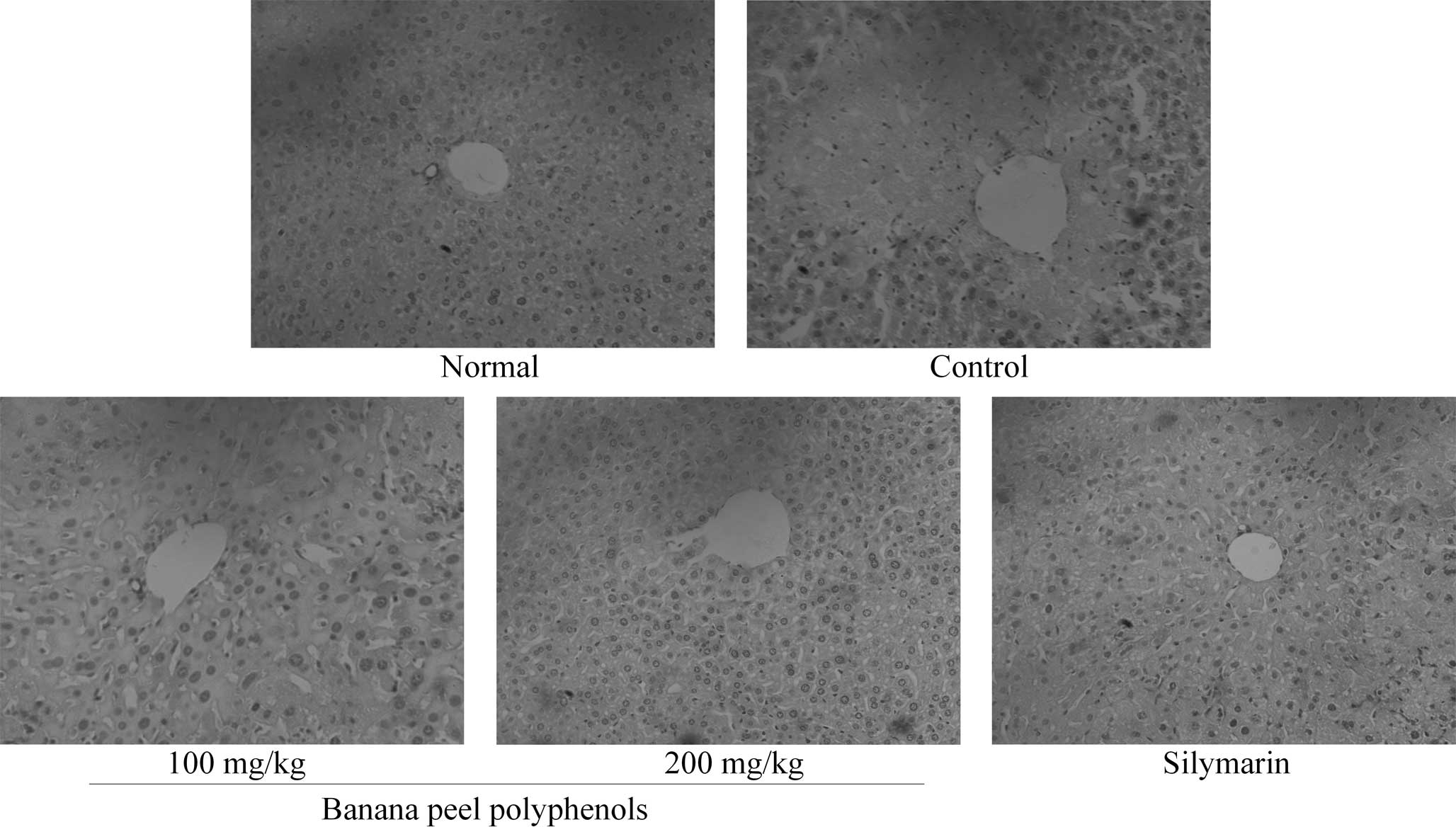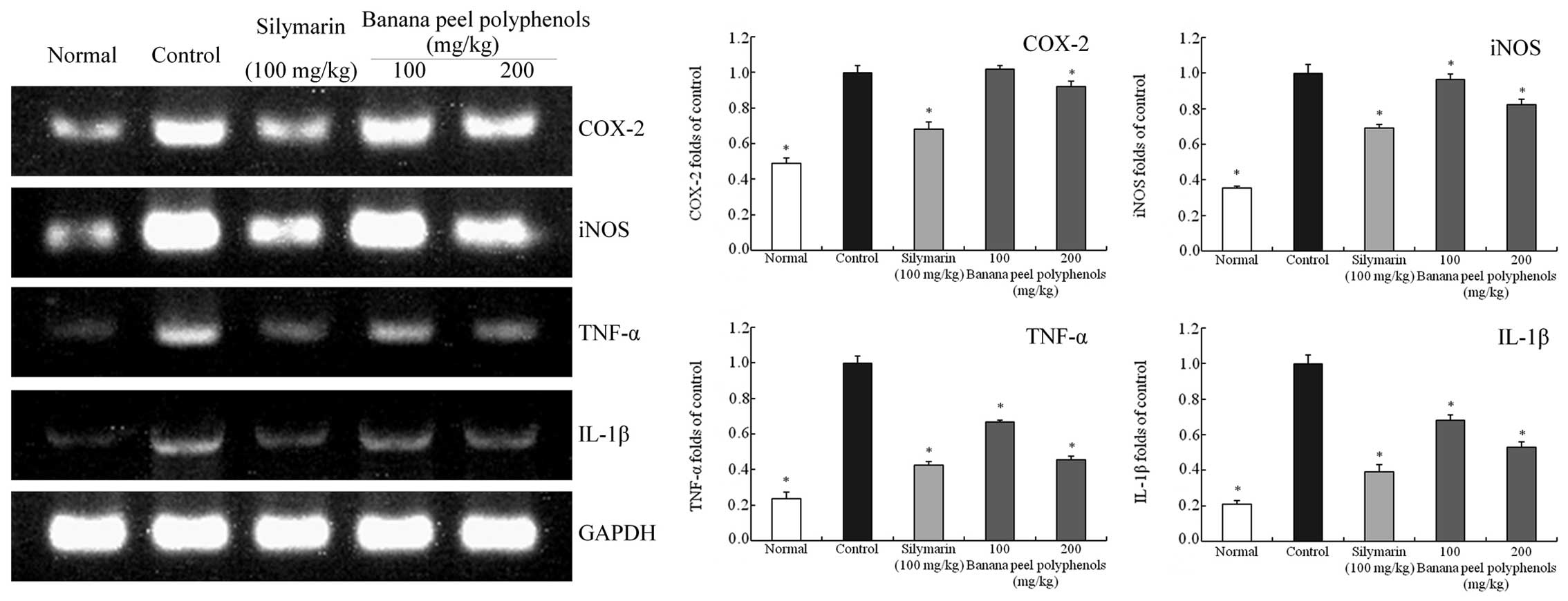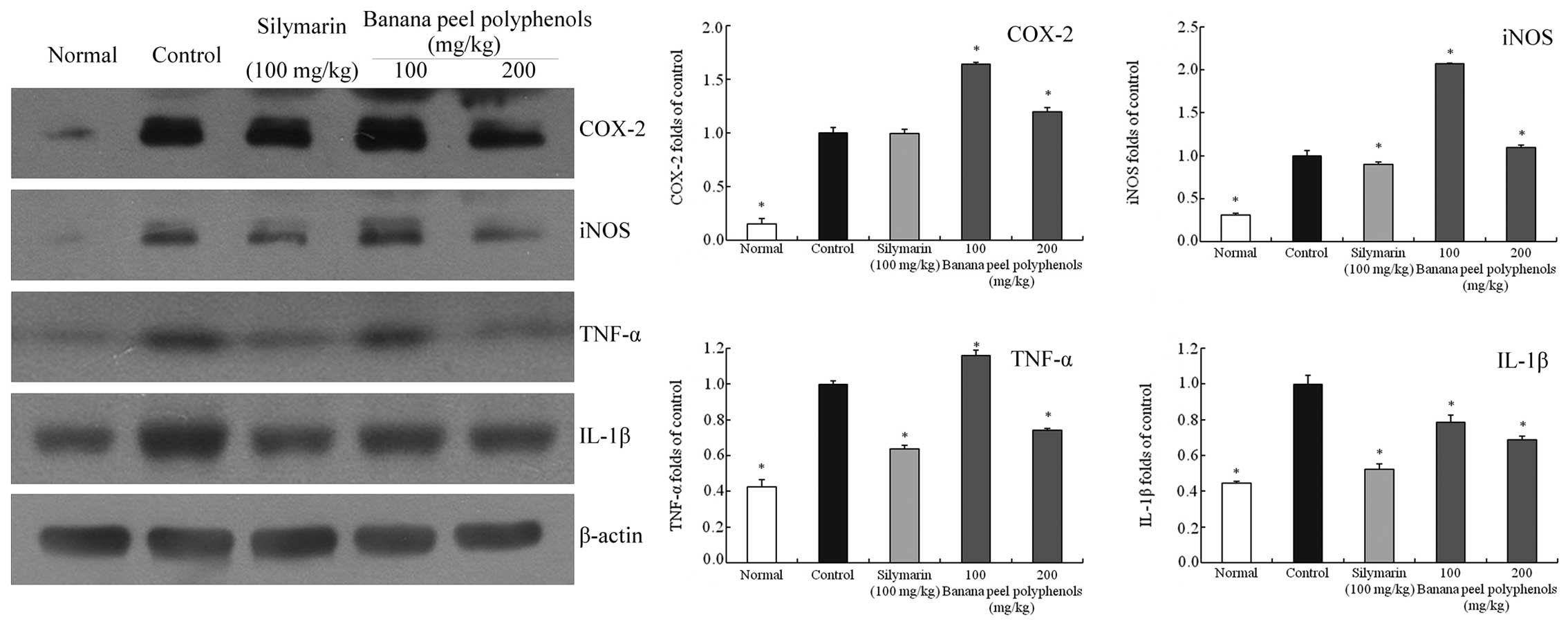|
1
|
Sang LW, Li L and Zheng FC: Study on the
comprehensive utilization of banana by-product. Hei Long Jiang Nong
Ye Ke Xue. 4:96–98. 2006.(In Chinese).
|
|
2
|
Liu S, Tang YF, Zhao QL, Li Y, Chen J, Li
Ml, Zhao H and Zhou Y: Extraction of polyphenols from banana peel
and anti-fungal effect research. Hu Nan Sheng Chang Sha Shi Xian
Jia Hu Hu Nan Shi Fan Da Xue Yi Xue. 6:12–14. 2009.(In
Chinese).
|
|
3
|
Kaviarasan S and Anuradha CV: Fenugreek
(Trigonella foenum-graecum) seed polyphenols protect liver
from alcohol toxicity: a role on hepatic detoxification system and
apoptosis. Pharmazie. 62:299–304. 2007.PubMed/NCBI
|
|
4
|
Kang MC, Kang SM, Ahn G, Kim KN, Kang N,
Samarakoon KW, Oh MC, Lee JS and Jeon YJ: Protective effect of a
marine polyphenol, dieckol against carbon tetrachloride-induced
acute liver damage in mouse. Environ Toxicol Pharmacol. 35:517–523.
2013. View Article : Google Scholar : PubMed/NCBI
|
|
5
|
Sebai H, Sani M, Yacoubi MT, Aouani E,
Ghanem-Boughanmi N and Ben-Attia M: Resveratrol, a red wine
polyphenol, attenuates lipopolysaccharide-induced oxidative stress
in rat liver. Ecotoxicol Environ Saf. 73:1078–1083. 2010.
View Article : Google Scholar : PubMed/NCBI
|
|
6
|
Cauwels A and Brouckaert P: Survival of
TNF toxicity: dependence on caspases and NO. Arch Biochem Biophys.
462:132–139. 2007. View Article : Google Scholar : PubMed/NCBI
|
|
7
|
Zhao X: Hawk tea (Litsea coreana
Levl. var. lanuginose) attenuates CCl4-induced
hepatic damage in Sprague-Dawley rats. Exp Ther Med. 5:555–560.
2013.PubMed/NCBI
|
|
8
|
Weber LW, Boll M and Stampfl A:
Hepatotoxicity and mechanism of action of haloalkanes: Carbon
tetrachloride as a toxicological model. Crit Rev Toxicol.
33:105–136. 2003. View Article : Google Scholar : PubMed/NCBI
|
|
9
|
Shang D, Xu XQ and Wu WJ: Study of
extraction of polyphenols from different states banana peels. Food
Sci Technol. 35:204–208. 2010.(In Chinese).
|
|
10
|
Jahan S, Khan M, Imran S and Sair M: The
hepatoprotective role of Silymarin in isoniazid induced liver
damage of rabbits. J Pak Med Assoc. 65:620–622. 2015.PubMed/NCBI
|
|
11
|
Li GJ, Sun P, Wang Q, Qian Y, Zhu K and
Zhao X: Dendrobium candidum Wall. ex Lindl. attenuates
CCl4-induced hepatic damage in imprinting control region
mice. Exp Ther Med. 8:1015–1021. 2014.PubMed/NCBI
|
|
12
|
Melgar S, Karlsson L, Rehnström E,
Karlsson A, Utkovic H, Jansson L and Michaëlsson E: Validation of
murine dextran sulfate sodium-induced colitis using four
therapeutic agents for human inflammatory bowel disease. Int
Immunopharmacol. 8:836–844. 2008. View Article : Google Scholar : PubMed/NCBI
|
|
13
|
Chen SS, Zhu K, Wang R and Zhao X:
Preventive effect of polysaccharides from the large yellow croaker
swim bladder on HCl/ethanol induced gastric injury in mice. Exp
Ther Med. 8:316–322. 2014.PubMed/NCBI
|
|
14
|
Liu D, He H, Yin D, Que A, Tang L, Liao Z,
Huang Q and He M: Mechanism of chronic dietary iron
overload-induced liver damage in mice. Mol Med Rep. 7:1173–1179.
2013.PubMed/NCBI
|
|
15
|
Liu H, Qi X, Cao S and Li P: Protective
effect of flavonoid extract from Chinese bayberry (Myrica
rubra Sieb. et Zucc.) fruit on alcoholic liver oxidative injury
in mice. J Nat Med. 68:521–529. 2014. View Article : Google Scholar : PubMed/NCBI
|
|
16
|
Poortahmasebi V, Alavian SM, Keyvani H,
Norouzi M, Mahmoodi M and Jazayeri SM: Hepatic steatosis:
prevalence and host/viral risk factors in Iranian patients with
chronic hepatitis B infection. Asian Pac J Cancer Prev.
15:3879–3884. 2014. View Article : Google Scholar : PubMed/NCBI
|
|
17
|
Nyblom H, Berggren U, Balldin J and Olsson
R: High AST/ALT ratio may indicate advanced alcoholic liver disease
rather than heavy drinking. Alcohol Alcohol. 39:336–9. 2004.
View Article : Google Scholar : PubMed/NCBI
|
|
18
|
Mabrouk M, El-Raziky M, Zayed N, Salama R,
El-Akel W, Awad T, El Beshlawy M and Esmat G: Clinical, biochemical
and pathological profiles of 5464 Egyptian chronic hepatitis
C-infected patients. Hepatogastroenterology. 60:1731–1735.
2013.PubMed/NCBI
|
|
19
|
Dickens H, Ullrich A, Runge D, Mueller B,
Olszewski U and Hamilton G: Anticancer drug
cis-4-hydroxy-L-proline: Correlation of preclinical toxicology with
clinical parameters of liver function. Mol Med Rep. 1:459–464.
2008.PubMed/NCBI
|
|
20
|
Srivastava SP, Chen NQ and Holtzman JL:
The in vitro NADPH-dependent inhibition by CCl4 of the
ATP-dependent calcium uptake of hepatic microsomes from male rats.
Studies on the mechanism of the inactivation of the hepatic
microsomal calcium pump by the CCl3 radical. J Biol
Chem. 265:8392–8399. 1990.PubMed/NCBI
|
|
21
|
Liu L, Fan H, Qi P, Mei Y, Zhou L, Cai L,
Lin X and Lin J: Synthesis and hepatoprotective properties of
Acanthus ilicifolius alkaloid A and its derivatives. Exp
Ther Med. 6:796–802. 2013.PubMed/NCBI
|
|
22
|
Karabulut AB, Kafkas ME, Kafkas AS, Onal Y
and Kiran TR: The effect of regular exercise and massage on oxidant
and antioxidant parameters. Indian J Physiol Pharmacol. 57:378–383.
2013.PubMed/NCBI
|
|
23
|
Yin L, Wei L, Fu R, Ding L, Guo Y, Tang L
and Chen F: Antioxidant and hepatoprotective activity of
Veronica ciliata Fisch. extracts against carbon
tetrachloride-induced liver injury in mice. Molecules.
19:7223–7236. 2014. View Article : Google Scholar : PubMed/NCBI
|
|
24
|
Ranjbar A, Sharifzadeh M, Karimi J,
Tavilani H, Baeeri M, Shayesteh Heidary T and Abdollahi M: Propofol
attenuates toxic oxidative stress by CCl4 in liver
mitochondria and blood in rat. Iran J Pharm Res. 13:253–262.
2014.PubMed/NCBI
|
|
25
|
Tomizawa M, Kawanabe Y, Shinozaki F, Sato
S, Motoyoshi Y, Sugiyama T, Yamamoto S and Sueishi M: Elevated
levels of alanine transaminase and triglycerides within normal
limits are associated with fatty liver. Exp Ther Med. 8:759–762.
2014.PubMed/NCBI
|
|
26
|
Song HY, Mao ZM, Yang LL, Liu T, Li DF,
Zhang L, Ge YL, Zheng PY, Liu P, Zhang XQ and Ji G: Dangfei
liganning capsules attenuate the susceptibility of rat nonalcoholic
fatty liver to carbon tetrachloride toxicity. J Tradit Chin Med.
31:327–333. 2011. View Article : Google Scholar : PubMed/NCBI
|
|
27
|
Sun Y, Yang X, Lu X, Wang D and Zhao Y:
Protective effects of Keemun black tea polysaccharides on acute
carbon tetrachloride-caused oxidative hepatotoxicity in mice. Food
Chem Toxicol. 58:184–192. 2013. View Article : Google Scholar : PubMed/NCBI
|
|
28
|
Schett G, Elewaut D, McInnes IB, Dayer JM
and Neurath MF: How cytokine networks fuel inflammation: Toward a
cytokine-based disease taxonomy. Nat Med. 19:822–824. 2013.
View Article : Google Scholar : PubMed/NCBI
|
|
29
|
Bae UJ, Yang JD, Ka SO, Koo JH, Woo SJ,
Lee YR, Yu HC, Cho BH, Zhao HY, Ryu JH, Lee SM, et al: SPA0355
attenuates ischemia/reperfusion-induced liver injury in mice. Exp
Mol Med. 46:e1092014. View Article : Google Scholar : PubMed/NCBI
|
|
30
|
Yang Y, Yang J and Jiang Q: The protective
effect of huperzine A against hepatic ischemia reperfusion injury
in mice. Transplant Proc. 46:1573–1577. 2014. View Article : Google Scholar : PubMed/NCBI
|
|
31
|
Bodienkova GM, Alekseev R, Boklazhenko E
and Kurchevenko S: Inflammation mediators in employees in chronic
exposure to neurotoxicants. Int J Occup Med Environ Health.
27:619–626. 2014. View Article : Google Scholar : PubMed/NCBI
|
|
32
|
Malekinejad H, Rezabakhsh A, Rahmani F and
Razi M: Paraquat exposure up-regulates cyclooxygenase-2 in the
lungs, liver and kidneys in rats. Iran J Pharm Res. 12:887–896.
2013.PubMed/NCBI
|
|
33
|
Ibrahim MA, Abdel-Gaber SA, Amin EF,
Ibrahim SA, Mohammed RK and Abdelrahman AM: Molecular mechanisms
contributing to the protective effect of levosimendan in liver
ischemia-reperfusion injury. Eur J Pharmacol. 741:64–73. 2014.
View Article : Google Scholar : PubMed/NCBI
|
|
34
|
Dong M, Hong T, Liu S, Zhao J, Meng Y and
Mu J: Hepatoprotective effect of the flavonoid fraction isolated
from the flower of Inula britannica against
D-Galactosamine-induced hepatic injury. Mol Med Rep. 7:1919–1923.
2013.PubMed/NCBI
|
|
35
|
Huang GJ, Deng JS, Huang SS, Lee CY, Hou
WC, Wang SY, Sung PJ and Kuo YH: Hepatoprotective effects of
eburicoic acid and dehydroeburicoic acid from Antrodia
camphorata in a mouse model of acute hepatic injury. Food Chem.
141:3020–3027. 2013. View Article : Google Scholar : PubMed/NCBI
|

















